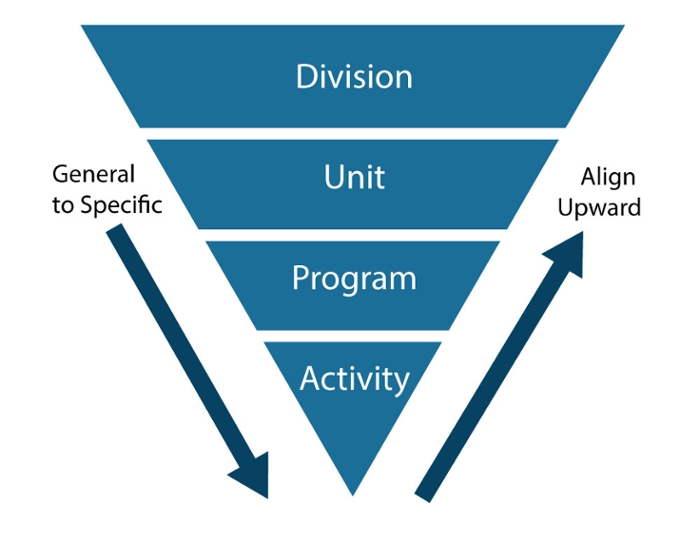Assessment Cycle

In Student Affairs and Campus Life, we consider assessment to be a five-step cycle. Each part of the cycle takes time and effort, and we've provided some resources to help you with this process.
Step 1: Develop/refine assessment plan
Outcomes can be differentiated into levels: the division, unit, program, and activity. Each of these levels of operation can and should have their own outcomes.
In each of these levels of operation, there are two types of outcomes: Learning Outcomes and Process Outcomes:
- Learning Outcomes focus on what the students should be learning (e.g., public speaking).
- Process Outcomes emphasize what metrics of operation each unit should be meeting (e.g., efficiency).

Below are some resources to help you with this process.
Familiarizing Yourself with the Division
- Student Affairs and Campus Life Strategic Plan (includes strategic goal areas)
- Student Affairs and Campus Life Learning Domains (PDF)
Identifying Unit-level Outcomes
Unit-level outcomes allow units to focus their resources and efforts and articulate their goals. Workshops thus far have delved into student learning outcomes on a program and activity level. In this workshop you will have the opportunity to draft and receive feedback from your colleagues on unit-level outcomes.
Writing Your Own Outcomes
Step 2: Identify outcome/question of interest
Student Affairs and Campus Life units are required to align their unit-level outcomes with their programs. This will assist in the planning of conducting assessment that is strategic, efficient, and meaningful
| Programs/Services | |||
|---|---|---|---|
| Program/Service 1 | Program/Service 2 | Program/Service 3 | |
| Unit Outcome 1 | x | x | |
| Unit Outcome 2 | x | x | |
| Unit Outcome 3 | x | ||
Blank Outcome Map Template (PDF)
Blank Assessment Schedule (PDF)
Step 3: Collect evidence
There are different ways that assessment can be collected. Qualtrics is a robust online survey-building tool that is highly customizable and easy to use.
Qualtrics is now available to UC San Diego faculty, staff and students.
Survey Resources
- Planning Your Survey: A Brief Primer on Strategies and Approaches (PDF)
- Writing Good Survey Questions: Tips and Advice (PDF)
- Survey Response Options (PDF)
Rubric Resources
Analyzing Data
Baseline provides useful tools to analyze your survey and rubric results. In Baseline you can:
- Input rubric observation results and see how the group performed on each metric.
- Conduct analysis using cross-tabs and filters.
- Report your results using graphics and charts.
Step 4: Analyze and interpret data
More info coming soon
Step 5: Use assessment findings
More info coming soon